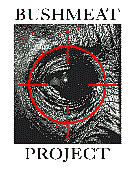The Bushmeat Crisis: Strategies, Solutions, and Social Change Capacity
Anthony L. Rose, Ph.D., Wildlife Protectors Fund
International Primatological Society / 18th Congress - Adelaide, Australia / January 12, 2001
The commercial consumption of wildlife is a crisis of global proportions with huge implications. The people of the world are literally eating wildlife to extinction. If this continues, no viable populations of apes and monkeys will re-main in the wild by 2050. Endangered apes in Africa -- gorillas, chimpanzees, and bonobos -- face a wave of local and subspecies extinctions during the next decade. The African bushmeat crisis is a symptom of rampant resource consump-tion, regional conflagration, and local anarchy. To succeed in this explosive context, we must enlist the involvement of the most wealthy, powerful, and morally motivated people and agencies in the world.
The overarching mission of conservation leaders will be driven by five strategic imperatives: 1) social and moral leaders must promote humanity's profound obligation to conserve wildlife and wilderness and to restore nature; 2) politi-cal and economic authority must place conservation on par with human rights and welfare; 3) conservationists must go beyond protecting biodiversity to assuring the synergy of human social systems and natural ecology; 4) public demand for intrinsic and spiritual values of nature must supersede utilitarian exploitation and underwrite massive long-term programs in conservation development; 5) all wildlife habitats must be considered sacrosanct, and human intrusion must be man-aged in a moral, businesslike, and competent way for the global good. These bold strategies are needed to counter the revolutionary activities of international exploiters who are radically manipulating the social order and cultural values of the African people to serve their personal and corporate pursuit of power and money. Because of this global assault on Af-rican life ways and values, social change and turmoil are the rule. In this milieu the practice of conservation must become proficient at understanding the context for change and working with its problems, causes, and solutions.
To succeed we must undertake a complex matrix of approaches to the crisis. Crucial areas for innovation divide into three groups. The first group of innovations are fundamental to initiating solutions: Group 1: Global Alliance for Wildlife Crisis Education and Control -- A) Cross-sector Alliances, B) Wildlife Protection Endowments, C) Conserva-tion Education Campaigns. The second set of innovations require urgent action: Group 2: Multidisciplinary Crisis Inter-vention Field Projects -- A) Health Monitoring Programs, B) Vital Ecosystem Protection, C) Bushmeat Control Mobiliza-tion, D) Militia and Refugee Management. The third list of innovations are sustaining to wildlife conservation Group 3: Long-term Conservation Development Programs -- A) Biosynergy Management, B) Bushmeat Alternatives, C) Na-ture/Wildlife Missions.
To develop these solutions will require major expansion of social change and management capacities in profes-sional and community stakeholder societies. Only by involving experts in applied social science, organization develop-ment, agribusiness, peace-keeping, environmental justice, media communications, and other key domains, will national and regional initiatives be comprehensive enough to curb and control wildlife commerce. This requires commitment to innovation and collaboration. The battles among egos, professions, organizations, cultures, religions, and nations must be set aside now. Innovative joint ventures among public, political, and professional stake holders is absolutely necessary. The future of wildlife and wild places, indigenous societies, human health, and global stability depends on it.
|

